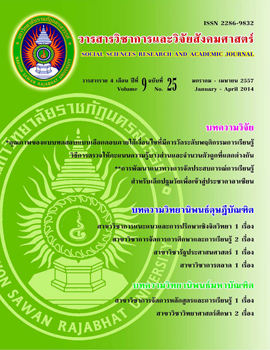คุณภาพของแบบทดสอบแบบเลือกตอบภายใต้เงื่อนไขที่มีการวัดระดับพฤติกรรม การเรียนรู้ วิธีการตรวจให้คะแนนความรู้บางส่วน และจำนวนตัวถูกที่แตกต่างกัน
Main Article Content
Abstract
บทคัดย่อ
การวิจัยครั้งนี้มีวัตถุประสงค์เพื่อเปรียบเทียบคุณภาพของแบบทดสอบคู่ขนานที่วัดระดับพฤติกรรมการเรียนรู้ วิธีการตรวจให้คะแนนความรู้บางส่วนและจำนวนตัวถูกต่างกัน ในประเด็นความเที่ยงตรงตามสภาพ ค่าความยากและค่าอำนาจจำแนกของข้อสอบ สารสนเทศของข้อสอบ สารสนเทศเฉลี่ยของแบบทดสอบ และประสิทธิภาพสัมพัทธ์ของแบบทดสอบ โดยเงื่อนไขระดับพฤติกรรมการเรียนรู้จำแนกเป็นพฤติกรรมการเรียนรู้ขั้นความจำ และขั้นสูงกว่าความจำ เงื่อนไขวิธีการตรวจให้คะแนนความรู้บางส่วนจำแนกเป็นแบบเลือกชุดตัวถูก (SST) และแบบตัดตัวลวง (ET) และเงื่อนไขจำนวนตัวถูกจำแนกเป็น ตัวถูกตัวเดียวและตัวถูกมากกว่า 1 ตัว กลุ่มตัวอย่างในการวิจัย ได้แก่ นิสิตคณะศึกษาศาสตร์ มหาวิทยาลัยทักษิณที่ลงทะเบียนรายวิชาการวัดและประเมินผลการศึกษา ปีการศึกษา 2555 จำนวน 174 คน เครื่องมือที่ใช้ในการวิจัยครั้งนี้ เป็นแบบทดสอบคู่ขนานที่ผู้วิจัยพัฒนาขึ้นจากแบบทดสอบวัดผลสัมฤทธิ์ทางการเรียน วิชาการวัดและประเมินผลการศึกษา จำนวน 8 ชุด ๆ ละ 10 ข้อ
ผลการวิจัย พบว่า
1. ความเที่ยงตรงตามสภาพของแบบทดสอบคู่ขนานทั้ง 8 ชุด ในภาพรวมไม่แตกต่างกันอย่างมีนัยสำคัญทางสถิติที่ระดับ .05
2. ค่าอำนาจจำแนกเฉลี่ยของแบบทดสอบทั้ง 8 ชุด ในภาพรวมและภาพย่อยรายเงื่อนไข ไม่แตกต่างกันอย่างมีนัยสำคัญทางสถิติที่ระดับ .05
3. ค่าความยากเฉลี่ยของแบบทดสอบทั้ง 8 ชุด ในภาพรวมแตกต่างกันอย่างมีนัยสำคัญทางสถิติที่ระดับ .01
4. แบบทดสอบแบบเลือกชุดตัวถูกวัดความรู้ขั้นความจำที่มีคำตอบถูกมากกว่า 1 ตัว มีค่าฟังก์ชันสารสนเทศของข้อสอบ, แบบทดสอบ และประสิทธิภาพสัมพัทธ์สูงที่สุด
Abstract
The purpose of this research was to compare the tests’quality between 8 parallel tests which lied on the different conditions on level of learning, partial knowledge scoring methods and number of correct answers in the following aspects: criterion related validity, item difficulty and discrimination parameters, item information, test average information and ratio of average information. The level of learning comprised remembering and higher than remembering level; partial knowledge scoring methods comprised the subset selection method (SST) and the elimination method (ET), and the number of correct answers comprised single and multiple correct answers. Research subjects were 174 bachelor students in Faculty of Education, Thaksin University who registered Educational measurement and evaluation subject from the second semester in 2012. Research instruments were 8 parallel tests of educational measurement and evaluation with 10 items each.
The results of this study were as follows:
1. The criterion related validity between 8 parallel tests was not significant different at the .05 level.
2. The mean item discrimination parameter between 8 parallel tests was not significant different at the .05 level.
3. The mean item difficulty parameter between 8 parallel tests was statistically significant at the .01 level.
4. The multiple correct answers on remembering level with scoring by the subset selection method (SSTRM) had the highest item information, test information and ratio of average information.


